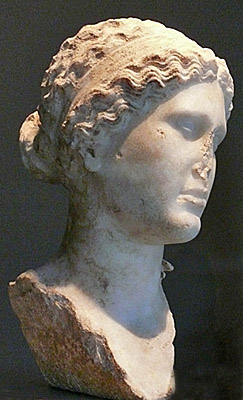
Hellenistic female head
3/2nd century BCE

Lalage is one of several women in Horace’s poetry who are considered to be more like Greek hetairai, hired for companionship and good conversation as well as sexual services, than the common prostitute. The women's Greek names and role as idealized objects of the poet's male gaze suggest that in most cases this assumption is correct. In this poem, addressed to his friend Aristius Fuscus, a poet and grammarian, Horace (65-8 BCE) ostensibly celebrates the powerful protection he derives from his devotion to his Lalage, a theme that the love poet Tibullus (c. 55-19 BCE) treats in his elegy to his beloved Delia (Elegiae I.2.25-32), where he boasts of the safety Venus grants to bold lovers. Horace's poem speaks rather to the beneficial effect on him of his dedication to his art than about his beloved as a woman, despite the graceful verbal allusions in its closing lines to love poems by the 6th century BCE Greek lyric poet Sappho (31.3-5) and Catullus (c. 84-64 BCE) (Carmina 51.5). Scholars debate the extent to which Horace is being playful or ironic here; his cool detachment from the object of his affection has led to the suggestion that Lalage (“Chatterer”) is in fact not a woman at all but rather a symbol of the musical power of his poetic art. While most modern readers believe that the audience is supposed to laugh at the speaker’s too-earnest faith in the power of love, in the nineteenth century a German composer and an American composer separately set this ode to music for academic audiences as a paean to the moral life. The work is composed in three thematically paired Sapphic strophes: 1-2 posit the power of moral integrity; 3-4 offer proof of the thesis from the love poet's experience; 5-6 propose that his love will remain unchanged wherever he is. Each strophe consists of four verses: the first three lines each contain five feet of eleven syllables (thus called hendecasyllabic), while the fourth line, called Adonic, consists of five syllables metrically identical to the last two feet of a dactylic hexameter line (for further discussion of his verse, see Horatian meters).
Integer vitae scelerisque purus
Non eget Mauris iaculis neque arcu
Nec venenatis gravida sagittis,
5 Sive per Syrtis iter aestuosas
Sive facturus per inhospitalem
Caucasum vel quae loca fabulosus
Namque me silva lupus in Sabina,
10Dum meam canto Lalagen et ultra
Terminum curis vagor expeditis,
Quale portentum neque militaris
15Nec Iubae tellus generat, leonum
Pone me pigris ubi nulla campis
Quod latus mundi nebulae malusque
Pone sub curru nimium propinqui
Solis in terra domibus negata:
Dulce loquentem.
Click on the underlined words for translation aids and commentary, which will appear in a small window. Click on the icon link![]() to the right of the text for related images and information.
to the right of the text for related images and information.